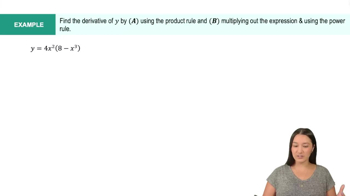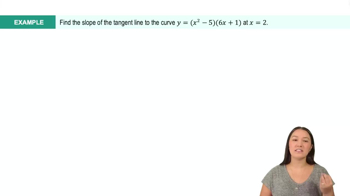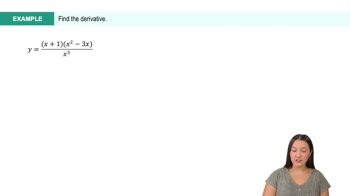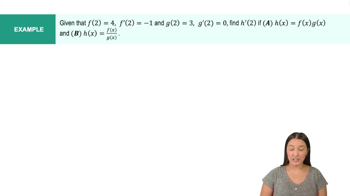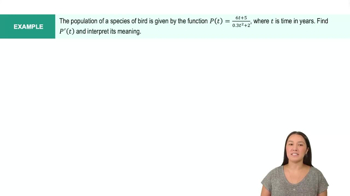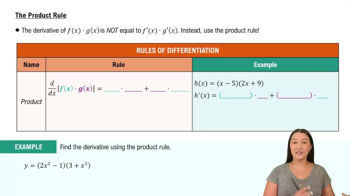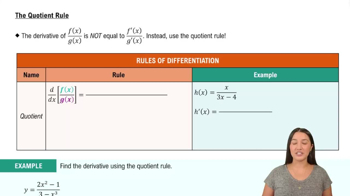Table of contents
- 0. Functions7h 52m
- Introduction to Functions16m
- Piecewise Functions10m
- Properties of Functions9m
- Common Functions1h 8m
- Transformations5m
- Combining Functions27m
- Exponent rules32m
- Exponential Functions28m
- Logarithmic Functions24m
- Properties of Logarithms34m
- Exponential & Logarithmic Equations35m
- Introduction to Trigonometric Functions38m
- Graphs of Trigonometric Functions44m
- Trigonometric Identities47m
- Inverse Trigonometric Functions48m
- 1. Limits and Continuity2h 2m
- 2. Intro to Derivatives1h 33m
- 3. Techniques of Differentiation3h 18m
- 4. Applications of Derivatives2h 38m
- 5. Graphical Applications of Derivatives6h 2m
- 6. Derivatives of Inverse, Exponential, & Logarithmic Functions2h 37m
- 7. Antiderivatives & Indefinite Integrals1h 26m
- 8. Definite Integrals4h 44m
- 9. Graphical Applications of Integrals2h 27m
- 10. Physics Applications of Integrals 2h 22m
3. Techniques of Differentiation
Product and Quotient Rules
Problem 3.4.61b
Textbook Question
Use a graphing utility to graph the curve and the tangent line on the same set of axes.
y = (x + 5) / (x - 1); a = 3
 Verified step by step guidance
Verified step by step guidance1
Step 1: Identify the function and the point of tangency. The function given is \( y = \frac{x + 5}{x - 1} \) and the point of tangency is at \( x = 3 \).
Step 2: Find the derivative of the function to determine the slope of the tangent line. Use the quotient rule: if \( y = \frac{u}{v} \), then \( y' = \frac{u'v - uv'}{v^2} \). Here, \( u = x + 5 \) and \( v = x - 1 \).
Step 3: Calculate the derivative \( y' \) at \( x = 3 \) to find the slope of the tangent line. Substitute \( x = 3 \) into the derivative expression obtained in Step 2.
Step 4: Determine the y-coordinate of the point of tangency by substituting \( x = 3 \) into the original function \( y = \frac{x + 5}{x - 1} \).
Step 5: Use the point-slope form of the equation of a line, \( y - y_1 = m(x - x_1) \), where \( m \) is the slope from Step 3 and \( (x_1, y_1) \) is the point from Step 4, to write the equation of the tangent line.
 Verified video answer for a similar problem:
Verified video answer for a similar problem:This video solution was recommended by our tutors as helpful for the problem above
Video duration:
7mPlay a video:
Was this helpful?
Key Concepts
Here are the essential concepts you must grasp in order to answer the question correctly.
Graphing Rational Functions
A rational function is a ratio of two polynomials. To graph such functions, it's essential to identify key features like intercepts, asymptotes, and the overall shape of the curve. For the function y = (x + 5) / (x - 1), understanding its behavior near the vertical asymptote at x = 1 and the horizontal asymptote as x approaches infinity is crucial for accurate graphing.
Recommended video:

Graph of Sine and Cosine Function
Tangent Lines
A tangent line to a curve at a given point represents the instantaneous rate of change of the function at that point. To find the equation of the tangent line at a specific point, you need to calculate the derivative of the function and evaluate it at that point. For the function given, evaluating the derivative at x = 3 will provide the slope needed to write the tangent line's equation.
Recommended video:
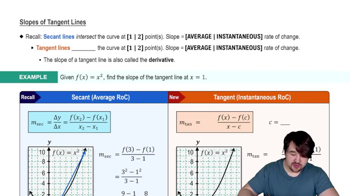
Slopes of Tangent Lines
Using Graphing Utilities
Graphing utilities, such as graphing calculators or software, allow for the visualization of functions and their properties. These tools can plot both the curve of the function and the tangent line simultaneously, making it easier to analyze their relationship. Familiarity with the utility's features, such as inputting functions and adjusting viewing windows, is essential for effective graphing.
Recommended video:

Graphing The Derivative
Related Videos
Related Practice



